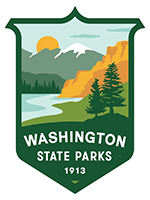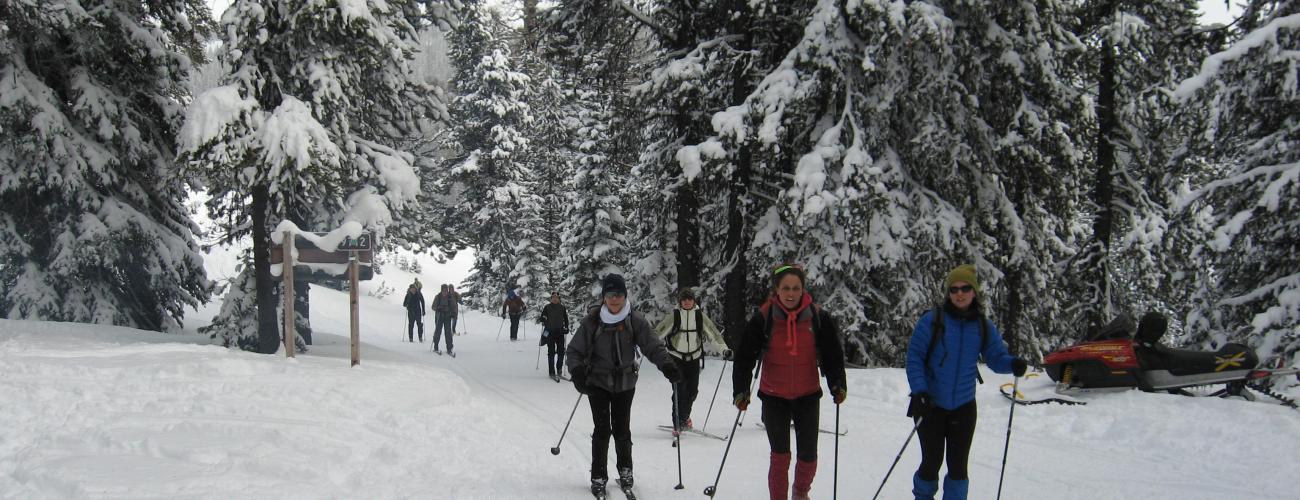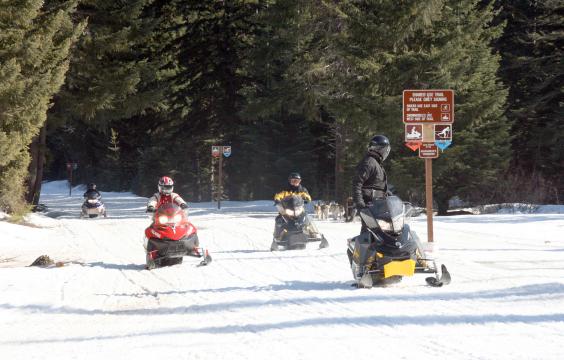Sno-Park Rules & Safety
Sno-Park Rules
When recreating at Sno-parks, please remember to:
- Respect all public and private property and the rights of all winter recreationists to enjoy the beauty of Washington Sno-Parks.
- Park considerately without blocking vehicles or driveways or impeding access to trails. When parking behind a snowmobile trailer, please allow enough room for operators to maneuver
- Keep to the right when meeting other recreationists and yield right of way to downhill traffic.
- Slow down and use caution when approaching or overtaking another user. Sound a pleasant warning when passing
- Respect designated areas, trail-use signs and established ski tracks
- Not block the trail when stopped
- Not disturb wildlife and avoid areas posted for wildlife protection or feeding
- Realize that your destination and travel speed are determined by your equipment, ability, terrain, weather and traffic on the trail.
- Offer assistance in an emergency
- Not interfere with or harass others
- Respect Wilderness Areas.
Right of Way
- Snowshoers — walk on the sides of the trail and stay off groomed ski tracks.
- Hikers and snowshoers – keep dogs on leash and off groomed ski tracks.
- Skate-skiers — keep off groomed ski tracks.
- Cross-country skiers – stay on groomed ski trails and slow down and announce your presence when coming up on snowshoers off trail. Leave dogs at home when not skijoring.
- Dogsled and skijoring teams— stay off groomed ski tracks.
- Skiers and snowshoers — yield to snowmobilers and dog teams.
- Snowmobilers — slow down when coming up on skiers, snowshoers and dog teams.
- Wheeled vehicles - are not permitted on any groomed trails. Anyone driving illegally on the groomed trails will be cited.
Dogs on Trails
- Dogs, except those operating in a seeing-eye capacity, are prohibited at Hyak Sno-Park.
- Dog sledding and skijoring are allowed only on snowmobile trails and designated non-motorized trails.
- Dogs are not allowed on groomed ski tracks or on non-designated trails. Check in with local ranger districts to determine if dogs are allowed.
- Protect your pet. Keep dogs on leash and under physical control at all times.
- Pack out their waste.
Winter Safety
Dress for the Weather
When venturing out into cold weather, it's important to wear clothing that holds the body's heat. Clothing should be windproof, water-repellent, and capable of allowing moisture to evaporate from the body. Down is good in dry conditions but becomes ineffective when wet. Cotton next to the skin draws heat out of the body when it becomes damp. Wool is the best protection. Certain new synthetics are also good.
Layering clothing is advisable, as the air pockets between fabrics hold the body's heat. Layered clothing also has the advantage of being removable if the temperature rises.
Be Prepared
When heading out for a day of winter sport activity, bring along the following items:
- Cell phone, two-way radio, or money for a phone call
- Compass
- Extra clothing
- Extra food and water
- First aid kit
- Flashlight
- Identification and emergency medical information
- Knife
- Map
- Matches / fire starter
- Sunglasses / goggles
- Thermal blanket
Hypothermia
Be prepared to recognize the signs of hypothermia. Hypothermia occurs when the body loses heat faster than the body can produce it. This causes the temperature of the main organs (heart, kidneys, lungs and brain) to drop. Both dry and wet cold can cause this condition.
The first stage of hypothermia is shivering of the body. Shivering is the body's natural reaction to cold. It produces heat. A person in this stage of hypothermia should move closer to artificial heat, eat hot food or add more clothing.
Once the condition has passed this stage, the cold will begin to affect the victim's brain. From this point on, the person will be able to recover only with the help of others. This more dangerous level of hypothermia occurs when the shivering stops. The person may look pale or blue. Movement will be slow. The body is reacting to heat loss by conserving all warmth for the main organs. Less blood is being pumped to the hands, arms, feet, legs and skin. The brain's reasoning power is affected, and main organs begin to slow down as their temperature drops.
At this point, it is vital that the person be removed from the cold. Wet clothing, if any, should be taken off. The person should be dried and wrapped in dry blankets, sleeping bags or clothing. Body-to-body contact may be necessary to warm the victim. If the person is conscious, give warm liquids slowly. Take the victim to a medical facility as soon as possible.
Protect Yourself From Hypothermia
- Know basic first aid, including CPR.
- Take a friend with you. Before you go, tell someone where you are heading and when they can expect you back.
- Wear appropriate layered clothing. Avoid cotton and down. Wear wool or suitable synthetics.
- Carry food, clothing, some sort of shelter and matches. Extra dry clothing may save your life.
- Maintain your energy supply by eating high-calorie foods frequently during your trip.
- Avoid becoming overly fatigued.
- Seek shelter from wind and rain if you are lost. Try to stay dry and put on extra clothing to keep warm. Cover yourself with a thermal blanket and dig a snow cave. Build a fire if dry wood is available.
Avalanches
While groomed trails are placed to avoid areas prone to avalanches, unpredictable snow conditions and erratic weather patterns can create an avalanche at any time. Be aware of the terrain around you and avoid areas that look unsafe. Signs of danger include old slide paths, recent avalanche activity, sounds or cracks and certain weather conditions.
Ensure a safe and enjoyable outing by checking on avalanche conditions before you go. Contact your local U.S. Forest Service Office or visit the Northwest Weather and Avalanche Center (NWAC) website.
Important Contact Information
- Mountain Pass Report: Call 511, 800-695-7623, or 206-368-4499, or visit the Washington State Department of Transportation website.
- Highway Advisory Radio Service: 1610 AM (at posted areas on Interstate 90 in the Snoqualmie Pass area) or 530 AM
- Northwest Weather and Avalanche Center website
- Washington State Parks Winter Recreation Program: 360-902-8684


